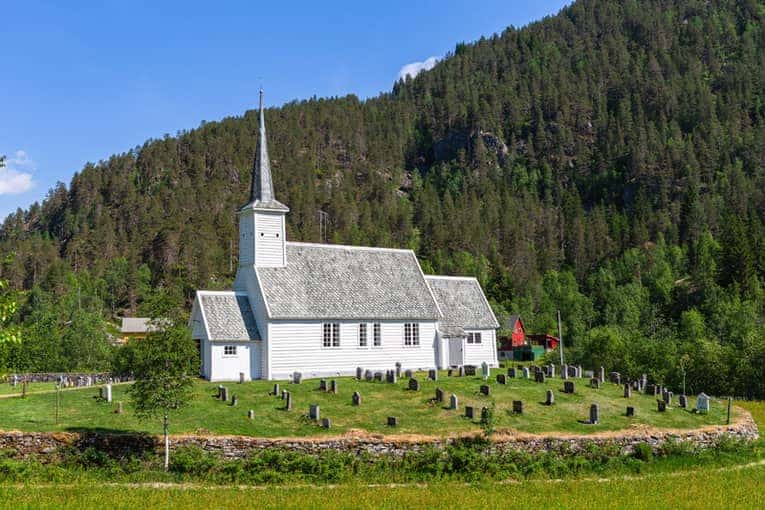The rise of the Vikings and the spread of Christianity are two of the most intriguing phenomena of the Middle Ages.
As the Norsemen grew in Northern Europe, Christian churches spread the gospel of Jesus Christ in Southern and Western Europe.
A lot of people wonder about the relationship between them, and whether or not the Vikings were Christians.
The religion the Vikings practiced is commonly referred to as Norse paganism.
However, many Vikings converted to Christianity when they encountered it outside Scandinavia or when missionaries arrived in the north.
The Christianization of Scandinavia was a significant factor in the demise of the Viking era.
Before encountering Christianity, most Norsemen were religious and practiced forms of Norse paganism.
So what would lead the Vikings to leave Norse paganism and embrace Christianity in droves? Were their conversion authentic?
Were Vikings who claimed to turn away from paganism, and to Christianity, telling the truth? Did they genuinely change their beliefs, and as a result, their way of life?
Keep reading to learn more
The Viking way of life has fascinated historians for centuries. See Did the Vikings have clans? to learn more.

Were Viking conversions to Christianity authentic?
In the Middle Ages, a collision between Vikings and churchmen was virtually unavoidable.
The Pope funded missionary efforts all over the continent, including in Northern Europe.
The church persistently poured money and resources into Scandinavia even though evangelistic progress in the region was slow.
From the north, the Vikings explored and raided further and further south in Europe, even to the area of the Mediterranean Sea, thereby becoming more exposed to the faith of Jesus Christ. [1]
Some historians believe that the vast majority were authentic. Other historians believe that most Viking conversions were nominal, i.e., they converted in name only.
The question of authenticity: Were their “conversions” the result of genuinely changed beliefs or something else? The answer is perhaps somewhere in the middle.
Some conversions were the result of changed religious beliefs and convictions, while others were driven by political or personal ambition and didn’t necessarily concern the teachings of Christianity. (Also see Traditional Viking Art: 7 Styles of the Period)
There isn’t a way of knowing what percentage were authentic and what percentage were nominal.
The best approach is to examine alleged conversions on a case-by-case basis.
For example, did their post-conversion behavior and convictions align with the teachings of Christianity?
Next, it’s important to consider why Vikings would genuinely convert to Christianity as well as why they would nominally convert.
The Vikings have a remarkable history in Scandinavia. See Scandinavia Before the Vikings to learn more.

Why would Vikings genuinely convert to Christianity?
Genuine conversions among the Norsemen likely resulted from finding the Christian message persuasive.
As the story goes, God, the Creator of the universe, sent his only son to Earth in order to die for the sins of all people.
The son, Jesus of Nazareth, then rose from the dead, and he offers eternal life to those that repent of their sin and put their trust in him.
People had positively responded to the Christian message for approximately 1,000 before the Vikings existed, and people continued to respond to it in the approximately 1,000 years after them.
Some Vikings were among them.
Why would Vikings nominally convert to Christianity?
There can be numerous reasons why an individual or a group of people would convert “in name” only.
- International alliances: First, converting to Christianity may have been politically expedient for some. Perhaps it would have solidified a relationship with a neighboring leader, like a king, who was a Christian.
- Ease of governing: Second, if common people in a particular area converted to Christianity, it may have been easier to govern them if they thought their leader shared their faith.
There were also smaller-scale motives people had to nominally convert to Christianity:
- Domestic unity: The leader of a village may have converted if the leader of the country, like a king, converted. And if the leader of a village converted, it may have encouraged people in the village to do the same.
- Lifestyle factors: Peaceful living, ease of business and trade, and the assurance of basic provisions, like safety, were motivations that encouraged nominal conversion.
- Home life: Yet another primary location for nominal conversions was the home. If the husband and father of a household converted to Christianity, due to genuine belief or not, often the entire household would often abandon paganism.
It is impossible to know if the average convert’s wife and children genuinely believed in the new religion they converted to, but the likelihood of nominal conversions in such a circumstance was high.
What was the Vikings’ fate? See What Happened to the Vikings? to learn more.
Evidence of authentic and nominal conversions
For many people, converting to Christianity means, in part, changing one’s beliefs and behaviors to conform to the bible’s teaching.
Some old behaviors are stopped because the Bible prohibits them.
Other new behaviors begin because the Bible encourages them.
If a person who converts to Christianity doesn’t exhibit any change from their previous way of life, some question whether the conversion was legitimate.
Sometimes certain “evidence” of genuine faith is applied in hindsight, which can call into question the authenticity of the past.
The case of St. Olaf: For example, Olaf II of Norway, i.e. “Saint Olaf,” achieved sainthood about a year after his death. Some historians point out that the miracles that were later applied to Olaf, were not mentioned during his life. Why not?
Furthermore, some miracles associated with him in Scandinavian literary sagas are clearly legendary.
For some, assigning evidence of faith to Olaf after his death makes them wonder about the real nature of his faith. [2]
Some leaders who converted to Christianity may have also found the Christian church’s structure appealing.
Churches at the time assigned overseers, like priests, bishops, and elders, over groups of people, like cities, towns, and villages.
Certain kings, for instance, could more easily govern people when they could appoint local leaders to carry out his decrees and enforce his laws.
Reasons for Christianity’s spread
Missions have always been important to Christian churches because spreading the gospel was an emphasis in the teachings of Christ.
Jesus himself identified as a missionary to the world as a whole, and he sent his disciples out into the world in a similar manner.
Christian missionaries had been at work for almost a millennium before Vikings arrived on the scene in Europe.
One of the important factors in effective missions is finances. It costs money to send missionaries to every corner of Europe.
It was the determination of the Pope at the time to fund evangelistic efforts in Scandinavia.
When setbacks occurred, the church could easily pour more money into the region.
The money helped missions persevere.
Another reason for Christianity’s spread was that after missionaries made inroads to a certain location, they didn’t quickly move on as Vikings were prone to do after raiding a particular area.
Missionaries often developed church leaders from among the locals, often the young men, who provided new churches with familiar names and faces.
Vikings didn’t look to proliferate their religion
The Vikings weren’t “evangelistic,” even in a secular sense of the word.
They weren’t concerned about converting non-pagans to paganism, and they didn’t attempt to turn non-Scandinavians into Vikings.
The Vikings didn’t make any effort to duplicate themselves using people from other countries and other faiths, and over time this impacted their total population and the sustainability of their culture.
Sometimes Vikings settled in lands they raided, but often they would pillage and move on to another or return home.
Historians note that Vikings who stayed in lands they conquered, often assimilated in different ways to their new culture, even adopting the faith common to the area.
As mentioned, this is one way Vikings converted to Christianity.
Churches in Scandinavia
People built more and more churches as Christianity grew in Scandinavia. They appeared in towns and in rural areas.
The style and decor of the churches reflected Norse architecture and art at first, but later reflected the artistry consistent with Latin Christianity in the Middle Ages.
The first churches were made out of wood, however those didn’t last long due to the climate of the region. Churches were eventually made out of stone. [3]
In the centuries after Christianity entered the Viking’s world, the church sent crusades of people to the Holy Land to liberate it from Muslim control.
The fighting that occurred in the crusades was brutal and bloody, and the church would later repent for their violence and death it caused.
Some historians believe that crusading was just raiding by another name.
This may suggest that while the church impacted the Vikings, in some ways, the Vikings impacted the church, too.
